
Sand is one of the most commonly used materials in construction, landscaping, and many other industries. It is essential to know the weight of the sand in order to accurately calculate the quantity needed for a particular project. 1 CFT (Cubic Feet) is a common unit of measurement for sand, but what does it actually weigh in kilograms? In this article, we will delve into the details of 1 CFT sand weight in kg and its significance in various applications. We will also explore different factors that can affect the weight of sand and how to calculate it accurately. So, let’s dig in and learn all about 1 CFT sand weight in kg.
1 CFT sand weight in kg | River & M sand weight
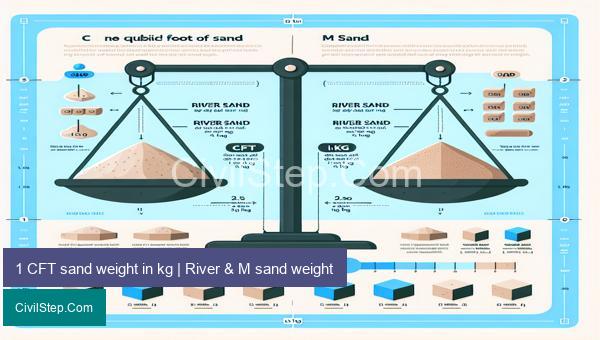
One cubic foot (CFT) of sand weighs approximately 50 kilograms (kg). This weight can vary slightly depending on the type of sand being used.
River sand, which is usually found in river beds and used for construction purposes, has a weight of around 50 kg per cubic foot. This type of sand is commonly used in concrete and masonry works, as well as for filling up gaps and leveling surfaces.
On the other hand, M sand, also known as manufactured sand, has a weight of approximately 45-48 kg per cubic foot. This type of sand is artificially manufactured by crushing rocks and has become popular in recent years due to its advantages over river sand. M sand is known for its superior quality and is commonly used in concrete and plastering works.
It is important to note that the weight of sand can vary depending on the moisture content, as wet sand will weigh more than dry sand. Additionally, the bulk density of sand can also differ depending on its origin and composition.
In the construction industry, the weight of sand is a crucial factor to consider in order to calculate the amount of sand required for a particular project. Knowing the weight of sand per cubic foot can help in accurate estimation and budget planning.
In conclusion, the weight of 1 CFT of sand is approximately 50 kg for river sand and around 45-48 kg for M sand. However, this weight can vary depending on factors such as moisture content and bulk density. Knowing the weight of sand is important for construction purposes and can aid in accurate calculations and budgeting.
The sand density and their weight
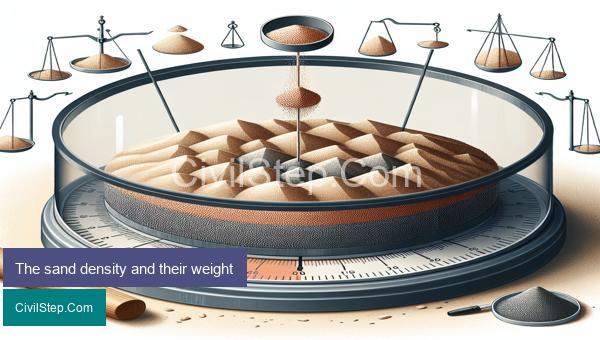
Sand is a naturally occurring granular material composed of finely divided rock and mineral particles. It is commonly used in construction and engineering projects due to its abundance, low cost, and relatively high strength.
The density of sand varies depending on its composition and moisture content. On average, dry sand has a density of approximately 1.6 grams per cubic centimeter (g/cm3). However, this can range from 1.2 g/cm3 for very fine sand particles to 1.8 g/cm3 for coarse sand particles.
In terms of weight, the density of sand translates to approximately 1.6 metric tons per cubic meter (t/m3). This means that a cubic meter of sand would weigh approximately 1.6 metric tons, which is equivalent to 1,600 kilograms or 3,527 pounds.
The weight of sand can also vary depending on the moisture content. Wet sand will be heavier due to the water present in between the particles. On the other hand, dry sand will be lighter as the water evaporates.
The weight and density of sand play a crucial role in civil engineering and construction projects. The knowledge of these properties is important in determining the amount of sand needed for a specific project and the load-bearing capacity of the ground beneath structures.
In addition to its weight and density, the angle of repose is another important factor to consider when working with sand. This refers to the maximum angle at which sand can be piled without it slumping or sliding. The angle of repose for dry sand is typically between 30-40 degrees, but it can vary depending on the size and shape of the sand particles.
Overall, the density and weight of sand are important considerations in the design and construction of various structures and infrastructures. As a civil engineer, it is essential to understand the properties of sand and how they can impact the success of a project.
1 CFT sand weight in kg

One cubic foot (CFT) of sand is equal to 35.3147 liters or approximately 0.035 cubic meters. The weight of sand varies depending on its density, but a rough average is around 1.5 tonnes per cubic meter. Therefore, the weight of 1 CFT of sand would be approximately 42.28 kilograms (kg). This weight may vary slightly depending on the type of sand and its moisture content.
To calculate the weight of sand in kilograms for a specific project, the volume of sand needed in cubic feet must first be calculated. This can be done by multiplying the length, width, and height of the area where the sand will be used. Once the volume in cubic feet is known, it can be multiplied by 42.28 kg to determine the weight of sand needed in kilograms.
Knowing the weight of sand is essential for various civil engineering applications, such as construction, road works, and landscaping. It allows engineers to accurately estimate the amount of material and equipment needed for a project and ensure safe and efficient execution.
In addition to its weight, sand also has other important properties that need to be taken into consideration, such as its grain size, shape, and composition. These factors can affect the strength, stability, and durability of structures and must be carefully considered during the design and construction processes. As a civil engineer, it is crucial to have a thorough understanding of these factors and their impact on the overall project.
Loose & dry sand density and their weight

Loose and dry sand is a common material that is used in various construction and engineering projects. It is composed of small particles of mineral and rock fragments, most commonly quartz, that have been eroded and weathered over time. The density and weight of loose and dry sand play a crucial role in determining its suitability for different construction applications.
Density of Loose and Dry Sand:
The density of sand is defined as the mass of sand per unit volume. The density of loose and dry sand can vary greatly depending on factors such as particle size, shape, and composition. However, in general, the density of loose and dry sand ranges from 1442 to 1602 kilograms per cubic meter (kg/m3). This translates to a range of 89.89 to 99.83 pounds per cubic foot (lb/ft3).
Factors Affecting Loose and Dry Sand Density:
1. Particle Size: The size of sand particles has a significant impact on its density. Smaller particles tend to have a higher density compared to larger particles. This is due to the interlocking of smaller particles, which leaves less space for air and results in a higher density.
2. Moisture Content: The density of sand can also be affected by its water content. Dry sand has a higher density compared to wet sand because water fills the gaps between particles and decreases the overall density.
3. Compaction: When sand is compacted, the particles are forced closer together, reducing the air spaces between them and resulting in a higher density.
Weight of Loose and Dry Sand:
The weight of sand is dependent on its density and volume. The volume of sand can be calculated by multiplying the length, width, and height of a pile of sand, while the weight can be calculated by multiplying the density by the volume.
For example, if the volume of a pile of sand is 1 cubic meter and its density is 1602 kg/m3, the weight would be 1602 kilograms.
Uses of Loose and Dry Sand:
Due to its relatively low density and weight, loose and dry sand is commonly used in construction and engineering projects. Some common applications include:
1. Concrete: Sand is an essential component of concrete mixtures, providing volume and strength. Its density and weight make it an ideal material for this purpose.
2. Fill material: Loose and dry sand is often used as a fill material in construction projects. Its relatively low density and weight make it easy to transport and compact, providing a stable base for structures.
3. Landscaping: Sand is commonly used in landscaping projects, such as in sandboxes and for creating garden paths. Its density and weight make it easy to manipulate and shape into desired designs.
In conclusion, the density and weight of loose and dry sand are important factors to consider in construction and engineering projects. They determine its suitability for various applications and can be influenced by factors like particle size, moisture content, and compaction. Understanding these properties of sand is crucial for proper use and management of this common construction material.
Dry sand density and their weight

Dry sand density refers to the amount of mass per unit volume of sand when it is completely dry without any moisture content. The unit for density is typically kilograms per cubic meter (kg/m³) or pounds per cubic foot (lb/ft³).
The density of dry sand varies depending on its composition and grain size. On average, the density of dry sand can range from 1400-1600 kg/m³ (87-100 lb/ft³). Coarser sands tend to have a lower density, while finer sands have a higher density.
Sand is a naturally occurring material that is made up of small rocks, minerals, and organic particles. Its density is affected by factors such as the shape, size, and density of the individual particles, as well as any compaction or settling that may have occurred.
The weight of dry sand can also be calculated by multiplying its density by the volume. For example, if the density of dry sand is 1500 kg/m³ and the volume is 1 cubic meter, the weight would be calculated as 1500 kg x 1 = 1500 kg.
The weight of dry sand is commonly used in construction and civil engineering projects. It is an important factor to consider when designing structures such as buildings, roads, and foundations. The weight of dry sand influences the load-bearing capacity and stability of these structures.
In addition to its use in construction, the weight of dry sand is also important in industries such as agriculture, landscaping, and sports. For example, the weight of sand is crucial in determining the amount of material needed for turfgrass sod installation, as well as in creating the proper weight and consistency for sandbags used for flood control.
In conclusion, the density and weight of dry sand are important properties that are influenced by various factors. As a civil engineer, understanding these properties is essential in designing and constructing safe and stable structures.
Dry packed sand density and their weight

Dry packed sand density refers to the compactness or weight per unit volume of sand that has been packed tightly together without the presence of moisture. It is an important aspect to consider in civil engineering as it affects the stability and strength of structures, such as retaining walls, embankments, and roads.
The density of dry packed sand is determined by its particle size and shape, as well as the degree of compaction. Fine-grained sand, with smaller particles, tends to have a higher density compared to coarse-grained sand. Round and smooth particles also have a higher density than angular and irregular-shaped particles. The density also increases as the sand is compacted more tightly.
The general range for dry packed sand density is between 1300 kg/m3 to 1700 kg/m3. A more specific density value can be determined by performing a laboratory test, such as the Proctor compaction test, which is commonly used in civil engineering.
The weight of dry packed sand will vary depending on its volume and density. For example, a 1 cubic meter of sand with a density of 1600 kg/m3 will have a weight of 1600 kg. This weight increases as the density of the sand increases.
In structural design, the weight of dry packed sand is an important factor to consider as it affects the load-bearing capacity of the structure. For instance, in the case of retaining walls, the weight of the sand behind the wall adds to the overall load and influences the design of the structure.
Additionally, the weight of dry packed sand also has implications in construction methods. The weight of sand can provide stability and prevent soil erosion in slopes and embankments. It can also act as a counterweight in temporary structures, such as scaffolding, to provide stability and prevent overturning.
In conclusion, dry packed sand density and weight are important parameters in civil engineering that affect the design and construction of various structures. It is crucial to understand and consider these factors to ensure stability, safety, and functionality of these structures.
Wet sand density and their weight

Wet sand density, also known as the bulk density of wet soil, refers to the ratio of the mass of the wet soil (including the moisture content) to its total volume. It is an important parameter used in geotechnical engineering for the design and analysis of structures and foundations.
The weight of wet sand is determined by its density and the volume of sand present. The greater the density and volume of sand, the higher the weight of the wet sand. The density of wet sand can be affected by various factors such as the type of sand, the amount of moisture present, and the compaction level of the sand.
The density of wet sand can be measured in pounds per cubic foot (lb/ft3) or in kilograms per cubic meter (kg/m3). The average density of wet sand is around 120 lb/ft3 (1922 kg/m3). However, this value can vary depending on various factors. For example, a denser sand with a higher proportion of particles will have a higher wet sand density compared to a looser sand with a smaller particle size distribution.
Moreover, the amount of moisture present in the sand also plays a significant role in determining its density. As the moisture content of sand increases, the density decreases. This is because water has a lower density compared to sand particles. Therefore, when moist sand is used, its weight will be lower compared to dry sand, even if they have the same volume.
The compaction level of the wet sand also affects its density. Compaction is the process of mechanically increasing the density of soil by removing air voids and rearranging soil particles. Compacted wet sand will have a higher density compared to uncompacted wet sand with the same amount of moisture.
To calculate the weight of wet sand, you need to know its volume and density. The formula for calculating the weight of wet sand can be written as:
Weight of wet sand = Volume of sand x Density of wet sand
For example, if the volume of sand is 1 cubic foot and its density is 120 lb/ft3, the weight of the wet sand will be:
Weight = 1 ft3 x 120 lb/ft3 = 120 lb
In conclusion, the wet sand density and weight are important parameters in civil engineering as they affect the stability and load-bearing capacity of structures and foundations. It is necessary to consider these factors in geotechnical investigations and design to ensure the safety and longevity of construction projects.
Wet packed sand density and their weight
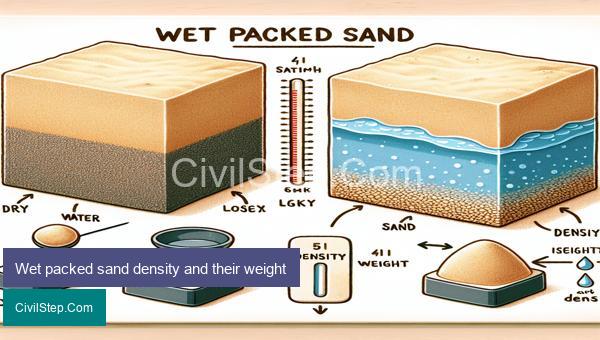
Wet packed sand is a type of sand that has been compacted and saturated with water. This method is often used in construction projects to create a stable and strong base for buildings, roads, and other structures. The density and weight of wet packed sand depend on various factors, including the type of sand used, the amount of water added, and the level of compaction.
Density of Wet Packed Sand:
The density of wet packed sand can vary widely, ranging from 2,000 kg/m³ (125 lb/ft³) for fine sands to 1,600 kg/m³ (100 lb/ft³) for coarser sands. This variation in density is due to the different particle sizes and shapes of the sand grains. Finer sand particles have a higher packing density and therefore weigh more per unit volume compared to coarser particles.
Factors Affecting Density:
The density of wet packed sand is affected by the level of compaction and water content. Compaction refers to the process of mechanically compressing the sand to increase its density and reduce its voids. The more compacted the sand, the higher its density will be. Water content, on the other hand, affects the density of wet packed sand due to its ability to fill the voids between the sand particles. The more water added to the sand, the lower its density will be.
Weight of Wet Packed Sand:
The weight of wet packed sand can also vary depending on the amount of water present. Generally, wet packed sand will weigh more than dry sand due to the added water weight. The weight of wet packed sand can range from 2,200 kg/m³ (138 lb/ ft³) to 1,800 kg/m³ (112 lb/ ft³) depending on the type of sand used and the level of compaction.
Importance in Construction:
The density and weight of wet packed sand are crucial factors in construction projects. It is important to achieve the desired density and weight of wet packed sand during compaction to ensure the stability and strength of the foundation. A higher density of wet packed sand can provide better support for the structure built on top of it, reducing the risk of settlement or failure. Additionally, knowing the weight of wet packed sand is essential in determining the load-bearing capacity of the soil and the overall stability of the structure.
In conclusion, the density and weight of wet packed sand are significant factors to consider in civil engineering projects. The careful control of these parameters during compaction is crucial in creating a strong and stable base for various construction projects.
1 CFT sand how many kg?

One cubic foot (CFT) of sand is approximately equal to 35.31 liters.
The weight of one CFT sand can vary depending on the type and density of sand. However, on average, one CFT of dry sand can weigh between 110-130 pounds (50-60 kg).
If the sand is wet or damp, its weight can increase drastically and may weigh up to 140 pounds (64 kg) per CFT.
It is important to note that the weight of sand can also vary based on its source and composition. For example, river sand may weigh less than desert sand due to its finer grain size.
In construction projects, the weight of sand is often calculated in metric tons (MT) or kilograms (kg) instead of cubic feet. In this case, 1 CFT of sand is approximately equal to 50 kg.
The weight of sand is an important consideration in construction and engineering, as it affects the stability and load-bearing capacity of structures. Accurate measurement and estimation of sand weight is crucial in order to ensure the safety and durability of a project.
1 unit sand how many kg
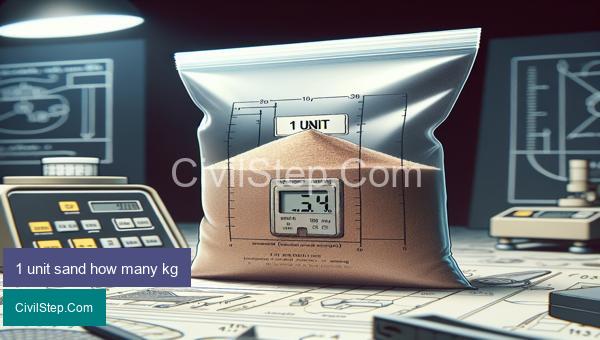
One unit of sand is equivalent to approximately 1.5 cubic feet or 0.044 cubic meters. The weight of sand varies depending on its density, but on average, one unit of sand weighs approximately 1400 to 1600 kilograms, which is equivalent to 3086 to 3527 pounds.
The unit “sand” is commonly used in construction and engineering projects as it provides a standard measurement for the amount of sand needed. It is also used to determine the volume of sand required for filling and leveling purposes.
Different types of sand have varying densities and therefore, the weight of one unit may differ. For example, wet sand has a higher density and will weigh more compared to dry sand. Similarly, fine sand has a higher density than coarse sand, therefore one unit of fine sand will weigh more than one unit of coarse sand.
Sand is a commonly used construction material that is composed of tiny grains of weathered rock and mineral particles. It is a versatile material and has many applications, including construction, landscaping, and filtration. In construction, sand is used for making concrete, mortar, and plaster, as well as for filling gaps and leveling surfaces.
In order to accurately determine the amount of sand needed for a project, it is important to know the density of the specific type of sand being used. This information can be obtained from the supplier or through testing. It is also important to consider the moisture content of the sand, as this will affect its weight and volume.
In summary, one unit of sand is a standardized measurement used in construction and engineering to represent a specific volume of sand. It is equivalent to approximately 1.5 cubic feet or 0.044 cubic meters and weighs approximately 1400 to 1600 kilograms. Knowing the weight and volume of one unit of sand is essential for accurately estimating and planning construction projects.
1 unit sand how many cft

Sand is a naturally occurring granular material composed of finely divided rock and mineral particles. It is one of the most commonly used construction materials, especially in civil engineering projects. One of the ways to measure sand is in terms of cubic feet (cft). In this article, we will discuss 1 unit of sand and how many cft it equals.
1 Unit of Sand:
When it comes to construction, contractors and engineers often use the term “unit” to refer to sand. This unit is not a standard unit of measurement like kilograms or meters, but rather a unit that is specific to each particular project. Depending on the location and availability of sand, the unit for measuring it can differ. For example, in some areas, one unit may equal 1 cubic meter of sand, while in others it may equal 1 cubic yard.
In the Indian subcontinent, 1 unit of sand is generally considered to be 100 cubic feet (cft). In some regions, it may also be referred to as 100 square feet (sft) or 100 cubic meters (m3).
How Many cft is 1 Unit of Sand?
As mentioned earlier, 1 unit of sand equals 100 cft. This means that 1 unit of sand is equal to 100 cubic feet of volume. To put it into perspective, 1 cubic foot of sand can fill a small laundry basket or a regular-sized shoe box. Therefore, 100 cft of sand can fill up a space of 10 feet length, 10 feet width and 1 foot height.
However, it is important to note that the density of sand may vary depending on its moisture content. The moisture content of sand can range from dry weight to fully saturated weight, which can significantly affect the volume of sand within a designated area.
How Much Sand Do I Need for My Project?
To determine the amount of sand you need for your project, you need to know the volume of the desired area in cubic feet. You can then use the following formula:
Amount of sand (in cft) = Area (in square feet) x Height (in feet)
For example, if you have a project area with dimensions of 100 feet length, 50 feet width, and 2 feet height, the amount of sand needed for this project will be:
Amount of sand = 100 x 50 x 2 = 10,000 cft
This means you will need approximately 100 units of sand for this project.
In conclusion, 1 unit of sand is equal to 100 cft. Depending on the location and availability of sand, the unit of measurement may vary. Knowing this conversion and using the formula provided can help you determine the amount of sand required for your civil engineering projects.
1 unit sand how many tons

One unit of sand typically refers to a specific volume of sand that is used for construction or other purposes. The actual measurement of one unit of sand can vary depending on the country or region, but it is generally equivalent to 27 cubic feet or 0.76455 cubic meters.
To convert one unit of sand to tons, we first need to determine the weight density of the sand. The weight density of sand can vary depending on the type of sand and its moisture content. Generally, the weight density of sand ranges from 100 to 145 pounds per cubic foot.
For this example, let’s assume the weight density of the sand is 130 pounds per cubic foot. To convert cubic feet to tons, we need to divide the weight density by 2,000 (the number of pounds in a ton). Therefore, one unit of sand would weigh approximately 0.065 tons (130 / 2,000).
In metric units, one unit of sand would weigh approximately 0.059 metric tons (0.76455 / 13.5, where 13.5 is the weight of one cubic meter of sand in metric tons).
It is important to note that these calculations are just estimates and the actual weight of one unit of sand can vary depending on the factors mentioned above. It is always best to consult with a supplier or use a certified weighing scale to get an accurate measurement of sand for construction projects.
1 CFT river sand weight in kg

One cubic foot (CFT) of river sand typically weighs between 95-100 pounds, which is equivalent to approximately 43-45 kilograms (kg). This weight can vary slightly depending on the moisture content, density, and origin of the sand. River sand is a commonly used material in construction projects due to its availability, low cost, and good quality.
The weight of river sand is an important factor to consider when planning and designing buildings, roads, and other structures. This is because the weight of the material directly affects the strength and stability of the structure. For example, a bridge built with lighter sand may not be able to withstand heavy loads and could potentially collapse.
To accurately estimate the weight of river sand in a project, it is recommended to conduct a moisture content test. This will determine the amount of water present in the sand, as water significantly affects the weight of the material. The density of the sand also plays a role in its weight, with denser sand weighing more than less dense sand.
In construction, the weight of river sand is typically measured in tons (2000 pounds) or cubic yards (27 cubic feet). Hence, the weight of 1 CFT of river sand in kg may vary depending on the conversion factor used. However, on average, 1 CFT of river sand weighs approximately 43-45 kg.
Overall, knowing the weight of river sand is essential for civil engineers to ensure the safety and stability of their projects. By accurately calculating the weight of the material, appropriate measures can be taken to ensure a well-designed and durable structure.
1 CFT M sand weight in kg

One cubic foot (CFT) of M sand weighs approximately 1620 kilograms (kg). M sand, also known as manufactured sand, is a substitute for river sand in construction. It is made by crushing granite or basalt rock into fine particles and washing it to remove impurities.
The weight of M sand varies slightly depending on the density and moisture content of the material. On average, one CFT of M sand contains 46% of stone dust, 49% of particles below 75 microns, and 5% of particles above 75 microns. This composition results in a heavier weight compared to traditional river sand, making it suitable for use in concrete and brickwork.
The following is a breakdown of the weight of M sand in different units of measurement:
1 CFT of M sand = 1620 kg
1 cubic meter (m³) of M sand = 1620 x 35.3147 = 57,236.7 kg
1 tonne (t) of M sand = 57,236.7/1000 = 57.24 t
1 pound (lb) of M sand = 1620 x 2.20462 = 3572.5 lb
1 ounce (oz) of M sand = 3572.5/16 = 223.3 oz
In comparison, one CFT of river sand weighs approximately 1530 kg, making M sand slightly heavier. This difference in weight can be attributed to the shape, size, and composition of the particles.
M sand is gaining popularity in the construction industry due to its cost-effectiveness, environmental benefits, and superior quality. Its weight and density play a crucial role in determining the amount of material required for a project and its strength. Engineers and contractors must carefully consider the weight of M sand when designing structures to ensure optimal performance.
Sand weight per cubic metre (m3)

Sand is a common material used in construction and can be found in various forms, such as fine, coarse, and mixed. The weight of sand per cubic metre (m3) can vary depending on its density, moisture content, and particle size.
The density of sand can range from 1300 to 1600 kilograms per cubic metre (kg/m3). Fine sand, which has smaller particles, tends to have a higher density than coarse sand. This means that one cubic metre of fine sand may weigh more than one cubic metre of coarse sand.
The moisture content of sand can also affect its weight per cubic metre. When sand is wet, it will be heavier than dry sand. Generally, wet sand can weigh around 1800 kilograms per cubic metre while dry sand can weigh around 1600 kilograms per cubic metre.
The particle size of sand can also impact its weight per cubic metre. As mentioned earlier, finer sand tends to have a higher density and therefore will weigh more per cubic metre compared to coarser sand.
To calculate the weight of sand per cubic metre, you can use the following formula:
Weight = density x volume
For example, if you have 1 cubic metre of dry, fine sand with a density of 1500 kg/m3, the weight of the sand would be 1500 kg (1500 kg/m3 x 1 m3 = 1500 kg).
It is important to note that the weight of sand per cubic metre may vary based on the source and composition of the sand. Other factors that can affect the weight of sand include compaction, moisture absorption, and impurities.
In construction, the weight of sand per cubic metre is an important consideration. Engineers and contractors must have an accurate estimate of the weight of materials in order to properly plan and design structures. Knowing the weight of sand can also help in determining the amount of sand needed for a project, as well as its transportation and storage requirements.
In conclusion, the weight of sand per cubic metre can vary depending on factors such as density, moisture content, and particle size. A density of 1500 kg/m3 is a good average to use for estimating the weight of dry, fine sand. However, it is important to consider the specific characteristics of the sand being used in order to get a more accurate calculation.
Sand weight per Yard
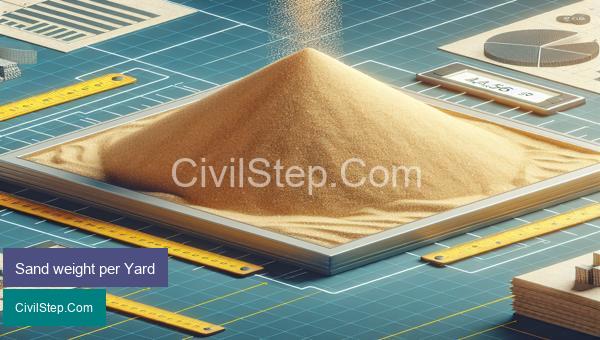
One of the most common materials used in construction and civil engineering projects is sand. It is a naturally occurring granular material composed of finely divided rock and mineral particles. The weight of sand per yard is an important factor to consider in many engineering and construction applications.
The weight of sand can vary depending on its source, composition, and moisture content. Generally, wet sand will weigh more than dry sand due to the presence of water in its pores. The density of sand also varies depending on its size, with finer sand particles having a higher density than coarser particles.
On average, the weight of sand per yard can range from 2,200 to 4,800 pounds (1,000 to 2,177 kg). This weight can be influenced by factors such as compaction, moisture content, and bulking. Compaction refers to the process of mechanically or manually increasing the density of the sand by reducing its volume. This can be done by using heavy equipment or by manually compacting the sand in layers. A well-compacted sand will have a higher weight per yard compared to a loose sand.
Another factor that can affect the weight of sand per yard is its moisture content. As mentioned earlier, wet sand will weigh more than dry sand due to the added weight of water. The moisture content of sand can also affect its compaction, as dry sand is easier to compact compared to wet sand.
Bulking is another factor that can affect the weight of sand per yard. It refers to the increase in volume of sand when it is loose. This is caused by the presence of air in between the sand particles. Bulking can significantly affect the weight of sand, as it can result in a higher sand volume while the weight remains the same.
To accurately determine the weight of sand per yard, it is important to consider these factors and conduct laboratory tests. Engineers use a standard method, known as the Standard Proctor test, to determine the maximum dry density and optimum moisture content of a given sand sample. This test is done by compacting several layers of sand in a standard mold using a specified amount of compaction energy.
In conclusion, the weight of sand per yard is not a fixed value and can vary depending on various factors, including compaction, moisture content, and bulking. It is important to conduct proper testing to determine the weight of sand accurately for engineering and construction purposes.
Sand weight per square foot

Sand weight per square foot refers to the amount of weight that one square foot of sand carries. This measurement is important in civil engineering as it is used in the design and construction of structures such as buildings, bridges, and roads.
The weight of sand per square foot can vary depending on factors such as moisture content, compaction, and grain size. On average, dry sand has a density of approximately 100 pounds per cubic foot. This means that a one-inch layer of sand covering one square foot would weigh approximately 100 pounds.
However, when sand is wet, it can weigh significantly more due to the added moisture. Wet sand has a density of approximately 130 pounds per cubic foot. This means that the weight of one square foot of wet sand can vary from 130 pounds to as much as 260 pounds, depending on the depth of the sand layer.
Compaction also plays a crucial role in determining the weight of sand per square foot. When sand is compacted, the grains are pushed together, reducing the air space between them. This leads to an increase in the weight of the sand. Compacted sand can have a density of up to 140 pounds per cubic foot, which means that one square foot of compacted sand can weigh up to 140 pounds.
The grain size of sand also affects its weight per square foot. Fine-grained sand, such as clay or silt, is heavier and denser than coarser sand, such as gravel or coarse sand. This means that a square foot of fine-grained sand can weigh more than a square foot of coarse sand.
In addition to weight, the angle of repose of the sand is also an important factor in civil engineering. This refers to the maximum angle at which a pile of sand can remain stable without sliding or collapsing. The angle of repose of sand can range from 30 to 35 degrees, and it is higher for dry sand than wet sand.
In conclusion, the weight of sand per square foot can vary depending on several factors, including moisture content, compaction, grain size, and angle of repose. It is essential for civil engineers to carefully consider these factors when designing and constructing structures to ensure the stability and safety of the project.
Sand weight per square metre (m2)

Sand is a common construction material used for various building projects, such as concrete, mortar, and masonry work. As a civil engineer, understanding the properties of sand, including its weight per square metre (m2), is essential for designing and constructing structures.
Sand weight per square metre refers to the weight of the sand per unit area, usually measured in kilograms (kg) or tonnes (t). The weight of sand can vary significantly depending on its type, moisture content, and compaction. For construction purposes, the weight of dry, compacted sand is most commonly used.
The weight of sand per square metre is primarily influenced by its density. The density of sand can range from 1300 to 1700 kilograms per cubic meter (kg/m3), depending on its type and composition. For example, desert sand has a lower density of around 1442 kg/m3, while wet sand has a higher density of around 2082 kg/m3.
To determine the weight of sand per square metre, we need to know the area and thickness of the sand layer. The formula for calculating the weight of sand is given by:
Weight = Volume x Density
In this case, the volume is equal to the area (m2) multiplied by the thickness (m). Therefore, the formula can be written as:
Weight (kg) = Area (m2) x Thickness (m) x Density (kg/m3)
For instance, if we have a sand layer with an area of 1 m2 and a thickness of 0.2 m, and the density of sand is 1500 kg/m3, then the weight of sand per square metre would be:
Weight (kg) = 1 m2 x 0.2 m x 1500 kg/m3 = 300 kg/m2
It is essential to note that the weight of sand per square metre varies depending on the type of sand. As mentioned earlier, different types of sand have different densities and, therefore, different weights per square metre. Additionally, moisture content and compaction can also affect the weight of sand. Wet, loose sand will weigh less per square metre than dry, compacted sand.
In conclusion, the weight of sand per square metre is an important consideration for civil engineers in construction projects. Understanding the weight of sand can help to determine the load-bearing capacity of structures and ensure proper foundation design. It is crucial to consider the type of sand and its density to accurately estimate the weight per square metre.
Conclusion
In conclusion, understanding the weight of 1 cubic foot (CFT) of sand in kilograms is important for a variety of reasons. It can help with construction projects, determining shipping costs, and understanding density calculations. By knowing the average weight of 1 CFT of sand (around 50 kg), individuals and businesses can make more informed decisions and be better equipped to handle sand related tasks. It is also important to note that the weight may vary slightly depending on the type and moisture content of the sand. Overall, having a solid grasp on this important unit of measurement will undoubtedly be beneficial in various industries and everyday life.
